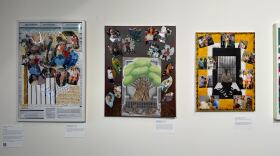A collective of Indigenous artists has bought 1.5 acres of land in South King County.
yəhaw̓ was formed in 2017 by a group of Indigenous, queer and female artists for what was supposed to be a yearlong series of pop-up art exhibits. But it lasted far beyond that.
The project culminated in an exhibition in Seattle in 2019 and involved more than 200 artists. This demonstrated to the group the need to keep going and provide a space to support and highlight Indigenous creatives. In 2021, yəhaw̓ became a nonprofit.
The purchase of the land – a former orchard in the Rainier Beach neighborhood – will allow them to provide a permanent space. Distinct from mainstream art institutions, the group is imagining something that incorporates gathering space and the outdoors.
"Thinking about mainstream arts often happening in this white cube gallery space; the idea of giving artists an opportunity to work outside where they can really respond to and build a relationship with the land directly felt super important and special," said Asia Tail, a co-founder of the collective and a citizen of the Cherokee Nation.
yəhaw̓ sees this land acquisition as a part of the bigger land rematriation movement. Tails said they use the word "rematriation" as opposed to repatriation to embrace an anti-colonial, or rather pre-colonial, perspective of stewarding the land.
"I think of rematriation as an attempt for Indigenous peoples to kind of reclaim that action in a way that feels maybe more culturally aligned," Tail said. "All of our wealth is built originally from the resources that the land provides, and that means spiritual wealth and emotional wealth and physical wealth and in many different capacities."
As Tail reflected on the land purchase she couldn't help but think about her ancestors. She explained the Indigenous concept of "seven generations."
"The idea that our work is connected to not only seven generations before us and the pathways and the groundwork that all of our ancestors laid out, but also thinking about our responsibility to seven generations into the future," Tail said.
"Seven generations ago, my Cherokee ancestors were being forced on the Trail of Tears... And so to think now, that seven generations later the prayers of the hopes or the fears that they may have had are sort of full circle, in this moment where I get to be part of this artist collective where we are reclaiming some space in the city, feels really powerful to me."
yəhaw̓ is at the beginning stages of planning and taking input from the community about how to use the land.







